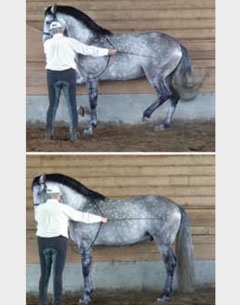
In international high performance dressage competition sport, most horses have great gaits and most riders ride accurate tests, so since the coming of Valegro, the deciding factor is now apparently lightness. How refreshing! I predict that, if this trend continues, we are going to see much-improved piaffe because it is the movement in which its quality is most dependent on lightness.
The Correct Piaffe
The piaffe needs to show elevation of the knees with, ideally, some vertical push from the front legs in order to achieve a modicum of suspension. Behind, the horse flexes the joints of his standing leg downward and flexes the joints of the lifted leg upward. The vertical push of the hind legs is absolutely minimal and must not be transferred to the croup, which remains lowered. If the horse’s hind legs are stiff and push too much upward, the horse can only balance himself by rooting his front feet. The flow of energy is then blocked by this bracing of the front feet, which puts the horse more and more on the forehand. If the front legs do not have a free path upward and forward, the torso of the horse stiffens and the hind legs either lose their activity or have to find a path upward, backward or sideways, but they cannot engage and flex down.
This problem, combined with the unresolved asymmetry of the horse, produces disengaged, uneven piaffe behind in which we see one hock lift more than the other and generally steps increasingly backward with each stride.Even more importantly, the synchronization and harmony of movement of the diagonal pairs are broken.
All this stems from the bracing of the front feet on the ground that is part and parcel of the resistance of the mouth against the bit. This is why all the classical authors who have written about the piaffe believe the horse’s lack of lightness, combined with the excessive use of the rider’s hand, is always responsible for defects in the piaffe. No amount of frantic spurring from a rider suffering from “performance anxiety” in the show arena will improve the quality of a horse attempting to piaffe out of this unsuitable balance.
When the horse is properly flexed in front, arching his neck from the base toward a very light contact, he recovers the freedom of movement of his front legs. The discreet action of the rider’s leg close to the girth can then increase the lift even more. As a natural reflex, the diagonal hind leg advances under the body in proportion to the front leg's advance in front of it.
The correct piaffe has its own “vibration” (the electric quality of a rhythmical energy) and horses start to piaffe on their own, as the famous KWPN stallion Totilas has demonstrated brilliantly and exceptionally. The only piece of training left is to teach the horse to stop piaffing on command. This is done by a light squeeze of the legs under an immobile seat (called “the comprehensive effect” or “effect of the whole,” a Baucher concept indispensable to all training). This is easily taught and helps horses stay calm in all situations and perform impeccable halts for as long as needed.
by JP Giacomini. Article was first published in Warmbloods Today September/October ’17 issue.
Related Links
Mastering Lightness: Understanding the Biomechanics
Classical Training: Is That Piaffe?
Now Available in English: Mitja Demitrij Cernac's Unique Book "Piaffe, Passage and Work in Hand"
Classical Training: The Piaffe - Placer et Laissez Faire